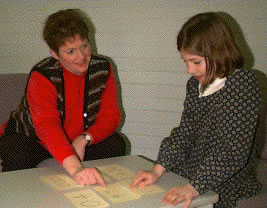Talking about Place Value
|
Comments: Text in italics |
 Interviewer: Caitlin: Zero point 4 is preferable. |
 Caitlin: Correct. Many teachers prefer nine and seven tenths. |

Caitlin: Incorrect. Should be zero point one six three to emphasise the difference from whole numbers. |

Caitlin: Incorrect. Should be zero point zero two five. Caitlin probably thinks 0.025 and 0.25 are the same. |

Caitlin: Reading decimals like this gives teachers a clue that the student may have little idea about the meaning of the decimal part. |

Caitlin: Incorrect. Should be four point two six. |

Interviewer: Caitlin: Interviewer: Caitlin: Interviewer: |

Caitlin: |

Caitlin: Caitlin sees the 26 as 2 tens and 6 ones although she knows there is something more that she doesn't understand. |
 Introduction
Introduction